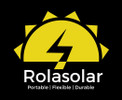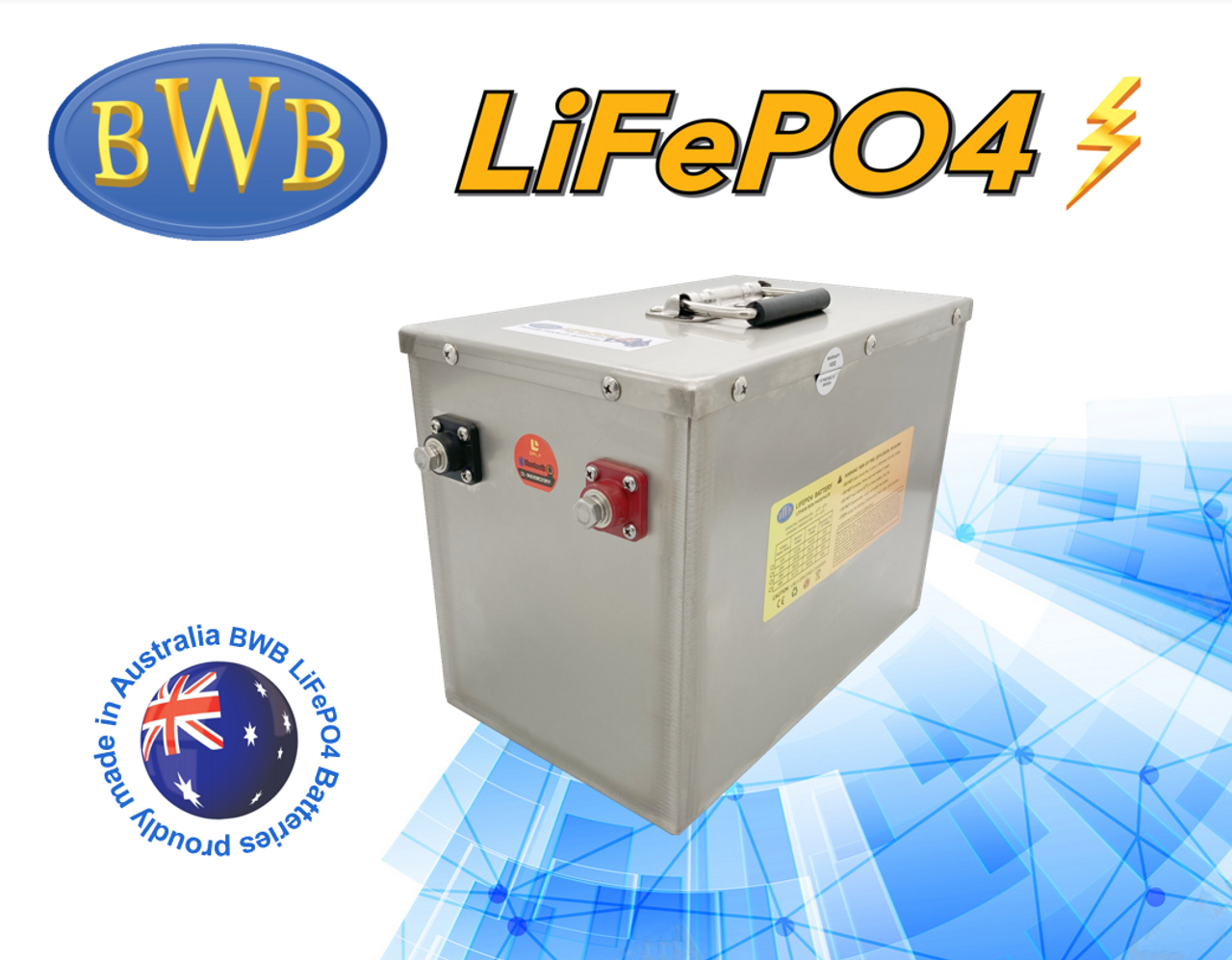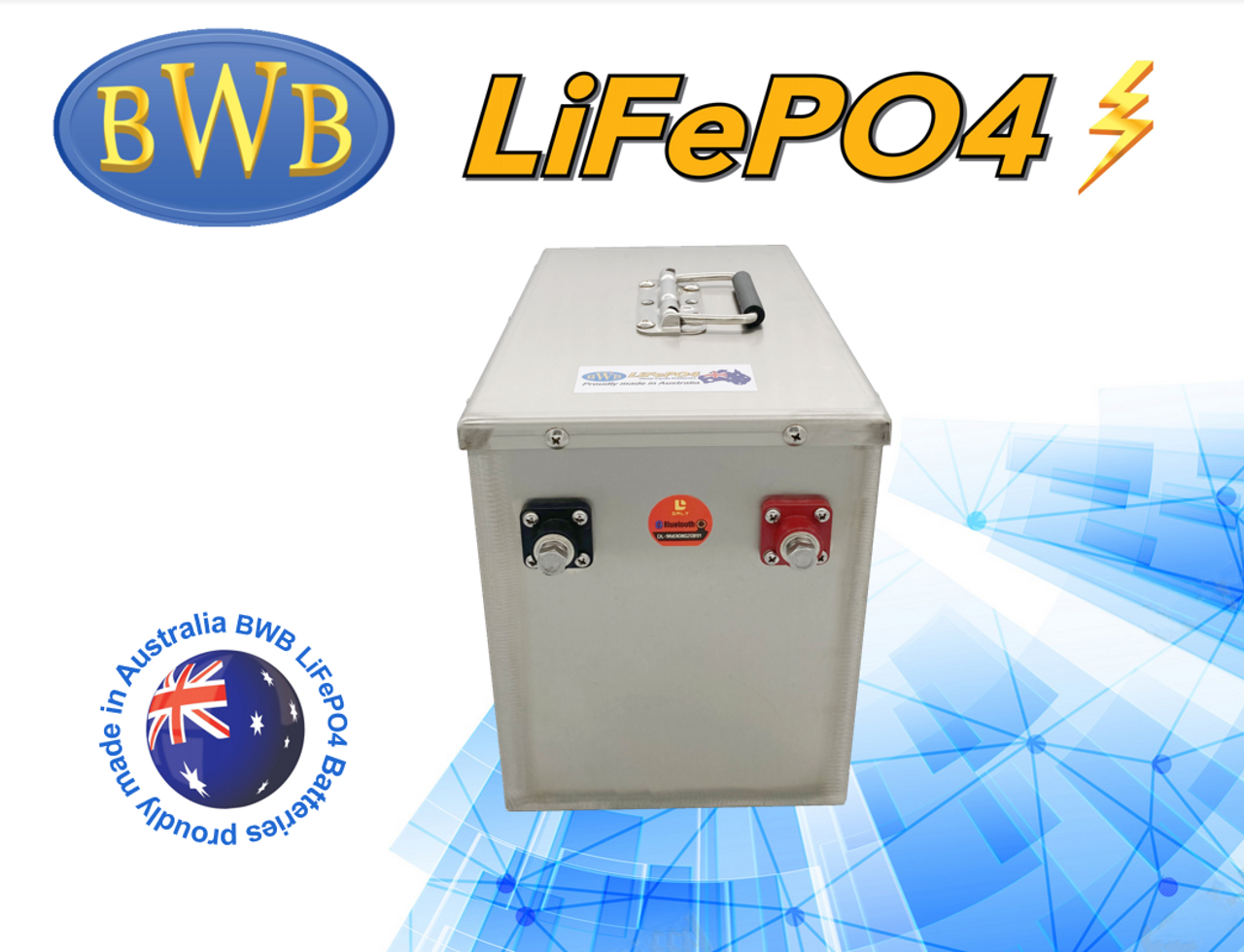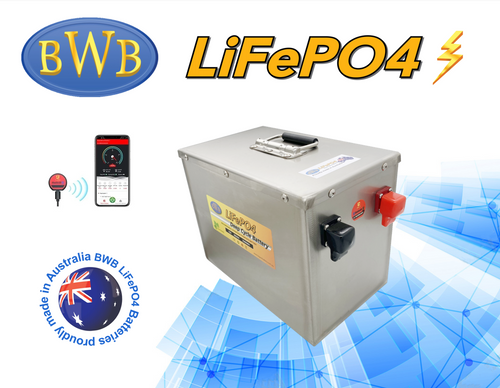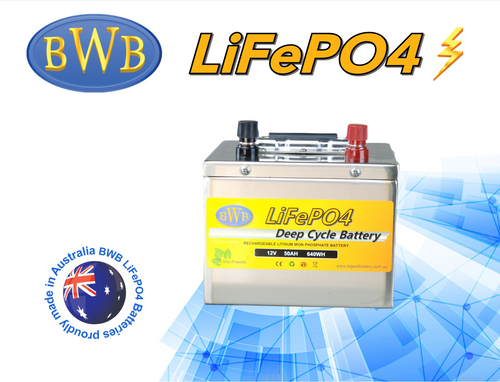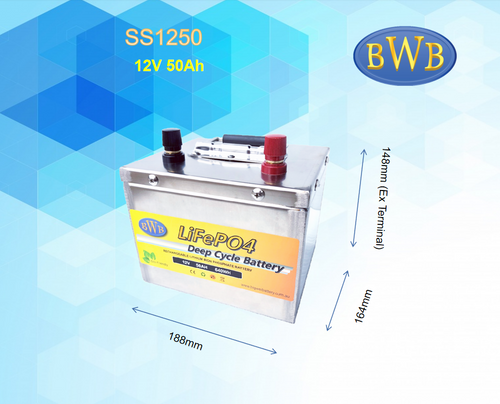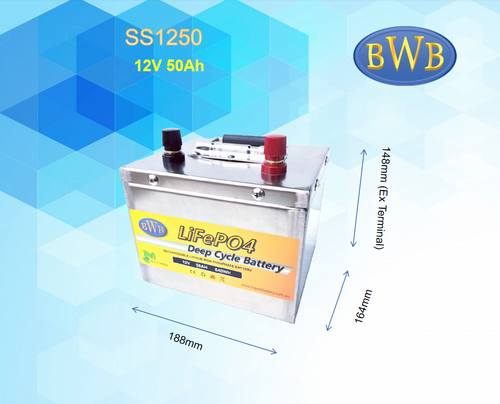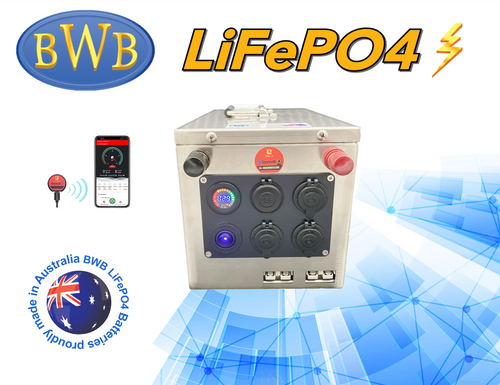Product Description
BWB 12.8V 200Ah 2560WH Lithium Iron LiFePO4 Deep Cycle Battery Stainless Box
FREE SHIPPING!
Lithium Iron Phosphate (LiFePO4) is a well-known lithium technology in Australia due to its wide use and suitability to a wide range of applications.
Characteristics of low price, high safety and good specific energy, make this a strong option for many applications.
Lithium iron phosphate (LiFePo4) is considered as the safest, most enviro-friendly, Excellent cycle life, most economical on long term costs and excellent temperature range from -20C to 55C.
- Class A cell
- Rated capacity: 200Ah
- 2560WH Prismatic LiFePo4 Cells
- Cycle Life: BEV (Battery Electric Vehicle) 3000, ESS (Energy Storage System) 8000
- Standard Charging & Discharging Rate: 0.5C (100A charging & discharge rate)
- Mximum Discharging Rate: 1C (200A discharge rate)
- Max Charge Voltage 14.6v
- Daly 100A BMS
- Stainless Steel Case with Handle
- 100A Rated Battery Terminals
- BWB LiFePO4 Model no. SS12100
- Warranty: 3 years (effective 01 June 2021)
- Weight: 13.8 kg
- Dimensions: 27.4 x 19 x 19.5 cm
Why LiFePO4?
Of all the lithium options available, there are several reasons why LiFePO4 has been selected as the ideal lithium technology for the replacement of AGM DEEP CYCLE. The main reasons come down to its favourable characteristics when looking at the main applications where AGM DEEP CYCLE currently exists. These include:
- Similar voltage to AGM DEEP CYCLE (3.2V per cell x 4 = 12.8V) making them ideal for AGM DEEP CYCLE replacement.
- The safest form of lithium technologies.
- Environmentally friendly –phosphate is not hazardous and so is friendly both to the environment and not a health risk.
- Wide temperature range.
Weight Comparison:
LifePO4 is one-third weight of AGM DEEP CYCLE
- AGM Deep Cycle 100AH – 29.5Kg
- LiFePO4 100AH– 10.5Kg
- Benefits
- Increases fuel efficiency
- In caravan and boat applications, towing weight is reduced.
- Increases speed Reduction in overall weight
- In boat applications, water speed can be increased.
- Longer runtime
Weight has a large bearing on many applications, especially where towing or speed in involved, such and caravan and boating. Other applications including portable lighting and camera applications where the batteries need to be carried.
Greater Life Cycle:
Comparison
- Up to 10 time the cycle life
- AGM Deep cycle – 300 cycles @ 100% DoD
- LiFePO4 – 3000 cycles BEV, 8000 ESS @ 100% DoD
Benefits
- The lower total cost of ownership (cost per kWh much lower over the life of the battery for LiFePO4)
- Reduction in replacement costs – replace the AGM up to 10 times before the LiFePO4 needs replacing
The greater cycle life means that the extra upfront cost of a LiFePO4 battery is more than made up for over the life use of the battery. If being used daily, an AGM will need to be replaced approx. 6 times before the LiFePO4 needs replacing.
Flat Discharge Curve:
Comparison
- At 0.2C (20A) discharge
- AGM – drops below 12V after 1.5 hrs of runtime
- LiFePO4 – drops below 12V after approximately 4 hrs of runtime
Benefits
- More efficient use of battery capacity
- Power = Volts x Amps
- Once voltage starts to drop off, the battery will need to supply higher amps to provide the same amount of power
- Higher voltage is better for electronics
- Longer runtime for equipment
- Full use of capacity even at high discharge rate
- AGM @ 1C(100A) discharge = 50% Capacity
- LiFePO4 @ 1C discharge = 100% capacity
This feature is little known but is a strong advantage and it gives multiple benefits. With the flat discharge curve of LiFePO4, the terminal voltage holds above 12V for up to 85-90% capacity usage. Because of this, fewer amps are required in order to supply the same amount of power (P=VxA) and therefore the more efficient use of the capacity leads to longer runtime. The user will also not notice the slowing down of the device (golf cart for example) earlier.
Along with this, the effect of Peukert’s law is much less significant with lithium than that of AGM. This results in having available a large percentage of the capacity of the battery no matter what the discharge rate. At 1C (or 100A discharge for 100AH battery) the LiFePO4 option will still give you 100AH vs 50AH for AGM.
Increased Use of Capacity:
Comparison
- AGM recommended DoD = 50%LiFePO4 recommended DoD = 80%
- AGM Deep cycle – 100AH x 50% = 50Ah usableLiFePO4 – 100Ah x 80% = 80Ah
- Difference = 30Ah or 60% more usable capacity
Benefits
- Increased runtime or smaller capacity battery for replacement
The increased use of the available capacity means the user can either obtain up to 60% more runtime from the same capacity option in LiFePO4 or alternatively opt for a smaller capacity LiFePO4 battery while still achieving the same runtime as the larger capacity AGM.
Greater Charge Efficiency:
Comparison
- AGM – Full charge takes approx. 8 hours
- LiFePO4 – Full charge can be as low as 2 hrs
Benefits
- Battery charged and ready to be used again more quickly
Another strong benefit in many applications. Due to the lower internal resistance among other factors, LiFePO4 can accept charge at a much great rate than AGM. This allows them to be charged and ready to use much faster, leading to many benefits.
Low Self Discharge Rate:
Comparison
- AGM – Discharge to 80% SOC after 4 months
- LiFePO4 – Discharge to 80% after 8 months
Benefits
- Can be left in storage for a longer period
This feature is a big one for recreational vehicles which may only be used for a couple of months a year before going into storage for the rest of the year such as caravans, boats, motorcycles and Jet Skis, etc. Along with this point, LiFePO4 doesn’t calcify and so even after being left for extended periods of time, the battery is less likely to be permanently damaged. A LiFePO4 battery is not harmed by not being left in storage in a fully charged state.
Product Specification
** For presentation purposes, the specifications on the tables below are for one (1) battery cell only.
Charge Mode & Specification:
Description/Item |
Specifications |
Remarks |
Standard Charge Current |
0.5C |
|
Standard Charge Voltage |
< 3.65V |
|
Standard Charge Mode |
Using 0.5C Constant Current (CC) to charge to 3.65V, then Constant Voltage (CV) at 3.65V to charge until charge current reaches the lower limit of 5.0+ 0.5A. |
|
Standard Charge Temperature |
25°C |
Cell Temperature |
Absolute Charge Temperature |
0-55°C |
Terminating charge process, once the cell temperature is beyond Absolute Charge Temperature. |
Absolute Charge Voltage |
<3.8V |
Terminating charge process, once the cell OCV is beyond Absolute Charge Voltage. |
Other Charge Mode:
Cell Temperature |
Standard Charge |
Rapid Charge |
Cell Temperature |
<0°C |
Prohibited to charge |
Prohibited to charge |
<0°C |
0-10°C |
Charge Current 0.1C |
Prohibited to charge |
0-10°C |
10-15°C |
Charge Current 0.2C |
Charge Current 0.3C |
10-15°C |
15-25°C |
Charge Current 0.3C |
Charge Current 0.5C |
15-25°C |
25-45°C |
Charge Current 0.5C |
Charge Current 1.0C |
25-45°C |
45-55°C |
Charge Current 0.3C |
||
>55°C |
Prohibited to charge |
||
Discharge Mode:
Description |
Parameters |
Remarks |
|
Standard Discharge Current |
100.0A |
* 25°C |
|
Maximum Continuous Discharge Current |
200.0A |
* N.A. |
|
Maximum Discharge Long-Pulse Current |
400.0A |
* 3 minutes maximum |
|
Maximum Discharge Short-Pulse Current |
600.0A |
* Cell temperature lower than 50°C* When SOC>40%, 60s maximum* When SOC<40%, 10s maximum |
|
Discharge cut-off Voltage |
>2.5V |
* N.A. |
|
Standard Discharge Temperature |
25°C |
* Cell Temperature |
|
Absolute Discharge Temperature |
-20–55°C |
Regardless of the discharge mode, the discharge process should be terminated, once the cell temperature is beyond Absolute Discharge Temperature. |
Charge cut-off and Protection:
Description |
Parameters |
Remarks |
Charge cut-off Voltage |
3.65V |
Terminating charge process when cell OCV reaches 3.65V. |
First Over-charge Protection |
>3.8V |
Limiting charge current to 0 when cell OCV reaches 3.8V. |
Second Over-charge Protection |
>4.0V |
Limiting charge current to 0 when cell OCV reaches 4.0V.Locking BMS before the problem is identified and resolved. |
Discharge cut-off Voltage |
2.5V |
Terminating discharge process when cell OCV reaches 2.5V. |
First Over-discharge Protection |
2.0V |
Limiting discharge current to 0 when cell OCV reaches 2.0V. |
Second Over-discharge Protection |
1.8V |
Limiting discharge current to 0 when cell OCV reaches 1.8V. Locking BMS before the problem is identified and resolved. |
Short Circuit Protection |
Prohibit Short Circuit |
Cutting off overcurrent devices (fuses, circuit breakers). |
Charging Time Protection |
<8h |
Terminating charge process when charging time exceeds 8 hours. |
BWB Battery Cells and BMS Features:
- 1 cell is 200AH 3.2V (8 cells = 200AH 12.8V total)
- Safety Pressure Release Valve
- Standard new safety technology for high-quality batteries.
- Prevents explosion caused by excessive internal pressures due to overcharging, short circuit, excessive temperature, battery deformation, or puncture.
- The safety valve on top is very important for an explosion-proof barrier. When the pressure inside the battery is build up, the safety valve opens to avoid explosion.
- No Memory Effect
- Rechargeable batteries work under conditions that are often not fully discharged, and the capacity will quickly fall below the rated capacity. This phenomenon is called the memory effect. There are memories like nickel-metal hydride and nickel-cadmium batteries, but lithium iron phosphate batteries do not have this phenomenon. No matter what state the battery is in, it can be used with charging, with no need to discharge and recharge.
- BMS (Battery Monitoring System)
- The lithium battery monitoring system is a charge and discharge protection for the series lithium battery pack. When the battery is fully charged, the voltage difference between the individual cells can be ensured to be less than the set value (generally ±20 mV), and the battery cells of the battery pack can be uniformly charged, effectively improving the charging effect in the series charging mode. Simultaneously detecting the overvoltage, under-voltage, overcurrent, short circuit, and overtemperature conditions of every single cell in the battery pack, protecting and extending the battery life; Undervoltage protection prevents each battery cell from damage due to over-discharge during discharge.
Learn more about our Lithium Iron Phosphate batteries HERE.
Learn more about our BMS HERE.
BWB Warranty and Product Support Infromation
3 YEARS LIMITED WARRANTY
BWB warrants BWB LiFePO4 Batteries to be free of defects in material and workmanship for the applicable 3-year warranty period. Warranty is only given to the original purchaser of this product. The warranty does not extend to subsequent purchasers or users. The 3-year warranty period starts from the date of the original purchase of the product.
The maximum liability of BWB under this limited warranty shall not exceed the actual purchase price of the product.
Return and Repair Policy
We provide a warranty against defects for the period and application as detailed. If you are experiencing any problems with your LiFePO4 Battery pack, please call us or email before returning the product. The battery will be tested as per our test procedure. Proof of purchase is required during the claim. Big Wei Battery will repair or replace any of the battery parts free of charge if found valid. The warranty excludes defects from after-sale damage, abuse, incorrect installation, or neglect. The benefits of this warranty are in addition to any other rights and remedies available under law. Costs of transportation to and from the BWB service centre will be shouldered by you. Our goods come with guarantees that cannot be excluded under the Australian Consumer Law. You are entitled to a replacement or refund for a major failure and compensation for any other reasonably foreseeable loss or damage. You are also entitled to have the goods repaired or replaced if the goods fail to be of acceptable quality and the failure does not amount to a major failure.
Limitations
This warranty does not cover damage or defects resulting from normal wear and tear including scratches, abrasions, chips, dents caused by mishandling, accidents, damage during shipping to our business office, unauthorized use or repair, continued use of battery even after it has stopped operating or malfunctioned, alterations, neglect, abuse, misuse, failure to follow recommended proper care and maintenance, acts of god, fire and flood. The natural capacity decrease is not supported within the 3-year warranty period.
Lifetime Free Service
We offer Free Lifetime Service. So, whether it’s still under warranty or beyond the warranty period, our service is Free. You will only have to pay for the parts or materials that need to be replaced when the product is beyond warranty.
How to make a Warranty Claim
Send us an email and including the following:
- Full details of alleged defect or fault and the circumstances surrounding the defect or fault.
- Provide relevant evidence of the claim, including photographs of the product installed and associated system wiring.
- Provide proof of purchase and payment.
Caution
Please DO NOT OPEN the battery box for whatever reason without our authorization as it will VOID the warranty and we are not responsible for any DAMAGE/s it may cause. These batteries are NOT designed for, nor should be fitted into an engine bay due to high heat. Damage may occur and is not covered by BWB LiFePO4 Battery Warranty.
